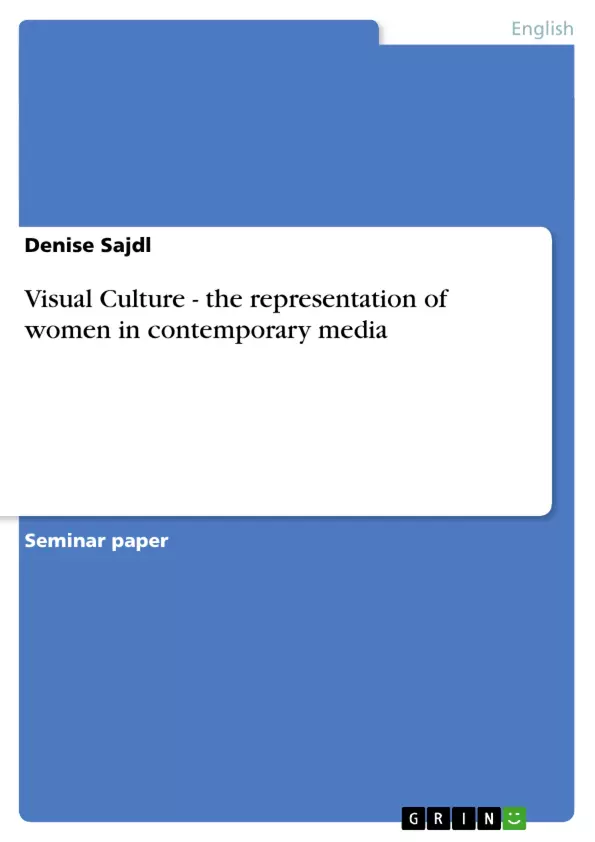Over the years, cultural images concerning women in society have changed dramatically. Thus, the woman we see in a current newspaper ad is presented totally differently from former times: powerful, more self-confident, energetic, dominant and autonomic are the visual characteristics we get in mind by looking at it. The traditionally typical male or – in this context more interesting - female role model does not seem to exist in our world anymore. There is no longer a clear distinction between the passive, soft, sensitive and very feminine looking woman on the one hand and the dominant, masculine, powerful and dynamic man on the other in these pictures.
The paper at hand will try to analyse these phenomena and show the development from a symbol of a happy family life and a caring housewife to the representation of a powerful and individual human being by regarding the representation of women in advertising in the past. But first, to illustrate this, it will be helpful to describe the term visual culture and how it works by including Roland Barthes´ ”The Rhetoric of the Image”. To show the great importance cultural images have in our lifes, how they are created to appear as realistic as possible, and how difficult it becomes for us today to distinguish between reality and illusion, I want to refer to Susan Bordo´s Twilight Zones. Some examples like women in sports advertisements, heroin chic or the computer-generated artificial “reality” we are confronted with by glamorized visual images of perfection will try to give a more detailed insight into illusions which we consider to be reality. In the final subchapter then it will be discussed if the sum of these created images could be described as “power feminism”, as Susan Bordo names it or if it is just a superficial trend.
Inhaltsverzeichnis (Table of Contents)
- Introduction
- What is Visual Culture?
- Roland Barthes "The Rhetoric of the Image"
- The representation of women in media in the past - Angel in the House
- How does advertising present women today?
- Women's bodies in sports ads
- "Heroin chic" and its results
- Perfect beauty - but unreal?
- A trend towards individuality - “power feminism”
- Conclusion
- Appendix
- Bibliography
Zielsetzung und Themenschwerpunkte (Objectives and Key Themes)
This term paper aims to analyze the evolving representation of women in contemporary media, focusing on advertising. It examines how visual culture has shifted from traditional portrayals of women to more complex and nuanced representations. The paper explores the influence of visual culture on viewers and investigates the impact of advertising on the construction of gender roles.
- The development of visual culture and its impact on gender representations
- The analysis of visual messages in advertising, particularly regarding women
- The role of visual imagery in shaping perceptions of femininity and masculinity
- The influence of cultural context and historical trends on visual representations of women
- The exploration of the concept of "power feminism" and its implications for female representation in advertising
Zusammenfassung der Kapitel (Chapter Summaries)
- Introduction: This chapter introduces the topic of the evolving representation of women in contemporary media, highlighting the shift from traditional gender roles to more complex portrayals. It sets the stage for the analysis of visual culture and its influence on advertising and consumer perceptions.
- What is Visual Culture?: This chapter explores the concept of visual culture, examining the interaction between the viewer and the viewed. It discusses the role of visual media in shaping perceptions and influencing consumer behavior, focusing on the intentional nature of advertising and its impact on the formation of visual subjects.
- Roland Barthes "The Rhetoric of the Image": This chapter examines Roland Barthes' theory of the rhetoric of the image, analyzing the different levels of signification within an image, particularly in advertising. It explains the linguistic, coded iconic, and noncoded iconic messages, using a specific advertisement as an example.
Schlüsselwörter (Keywords)
The main keywords and focus topics of this paper include visual culture, representation, gender, advertising, media, femininity, masculinity, power feminism, cultural images, advertising image, rhetoric of the image, coded iconic message, noncoded iconic message, visual subjects, visual events, consumer culture.
- Quote paper
- Denise Sajdl (Author), 2003, Visual Culture - the representation of women in contemporary media, Munich, GRIN Verlag, https://www.grin.com/document/46768



